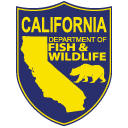Welcome to the Marine Management News Fish Identification Quiz for February 2015! We’re stretching the definition of “fish” to the legal limit with this quiz, by selecting a crustacean for identification! (The legal definition of “fish” in California Fish and Game Code (§45) includes not only wild fish but also crustaceans, mollusks, invertebrates, and amphibians, and any “part, spawn, or ova thereof.”) We felt it was only fair to include these multi-legged critters in at least one identification quiz, given their popularity. So, here’s your chance to show off your shellfish identification knowledge and win an official Department of Fish and Wildlife (CDFW) fish tagging cap! To qualify for the drawing, simply send the correct information to AskMarine@wildlife.ca.gov by March 31, 2015 identifying:
- The species of crab pictured below (scientific name) and an accepted common name, and
- The daily bag limit, as found in the current Ocean Sport Fishing regulations booklet
Be sure to enter “February MMN Fish Quiz” as the “Subject” of your e-mail. The winner will be selected during a random drawing from all correct answers received by March 31, 2015.  See the correct answer to the quiz
See the correct answer to the quiz
This crab begins its life journey as an egg carried around on its mother’s abdomen with up to a few million of its brothers and sisters. Females carry the bright orange egg masses until the eggs hatch in six to eight weeks. The tiny free-floating young undergo six developmental molts that involve shedding their shells, growing larger, and changing shape with each molt over about a six month period, until they settle to the sea floor as juvenile crabs.
Once settled, the juvenile crabs continue to grow and molt, less frequently as they get older. Male crabs grow larger than females, reaching up to 8 in. across. Both sexes are thought to live for at least five to six years.
This crustacean is both a predator and a scavenger, feeding on a variety of other invertebrates. Strong, crushing claws allow them to prey on heavy-shelled animals such as snails, clams, abalone, barnacles, and oysters. They have a well-developed sense of smell, which allows them to detect and locate food at a distance. This crab is preyed upon by a variety of other creatures, especially while it is still small. Fishes such as cabezon, barred sand bass and several species of rockfish are known to feed on them. Invertebrates including octopus and certain sea stars also prey on this crustacean.
As it grows, this crab generally becomes less susceptible to predators, except when its shell is soft just after a molt. Sea otters are one of the few effective predators on the more mature, hard-shelled crabs. This species of crab can be found from Kodiak Island, Alaska to central Baja California. It inhabits waters from the low intertidal zone to depths of 300 ft or more.
Although it can be found in all ocean waters off California, it is more abundant in northern California. This crab did not appear in commercial California Department of Fish and Game landing records until 1928, and before 1950 there was no separate market category for reporting landings of this particular species. Annual landings have risen from 20,000 lb. in 1950 to an average of 1.2 million pounds since 1991.
This tasty crustacean is among the more popular species of crab caught by recreational crabbers off California, who enjoy the flavorful meat despite the task of breaking through its very hard shell. Recreational crabbers catch this crab using baited hoop nets, loop traps and crab pots. It is also caught by hand off intertidal rocks at low tide, and at deeper depths by divers.
If you think you know this species of crab, enter the prize drawing by sending an e-mail to CDFW at AskMarine@wildlife.ca.gov by March 31, 2015 with the correct scientific name, an accepted common name, and the daily bag limit as found in the current Ocean Sport Fishing regulations booklet. Again, be sure to enter “February MMN Fish Quiz” in the “Subject” portion of your e-mail. Good luck!

UPDATE — APRIL 13 Congratulations go out to Kyle Max of McKinleyville, California for correctly identifying the February 2015 mystery (shell)fish as a red rock crab, Cancer productus. The daily bag limit for red rock crab is 35 crab per person and in possession, per California Code of Regulations Title 14, Section 29.85(b)(2). You can find this regulation on pg. 51 of the current Ocean Sport Fishing regulations booklet.
Kyle works as a fish and wildlife technician for the National Park Service. “I enjoy salmon and trout fishing, diving for abalone, hunting big game, waterfowl, and upland birds – pheasants and dove,” he said. At any given moment, Kyle says he would “rather be outside walking my dogs, hiking, backpacking, camping, on a river, or working in the yard. I just love being outside in nature doing something either for my job or pleasure.” Congratulations again Kyle!
post by Mary Patyten, CDFW Research Writer ♦ crab photo courtesy ODFW ♦ quiz winner photo by B. Clueit

